Although the first chapters in the history of Cloud Computing (cloud computing) were written as early as the 1960s, i.e. 70 years ago, its advantages only became public and popular with the emergence of the company Salesforce in 1999: it brought a cloud-based platform that helps companies manage customer interactions, and its entry into the market ushered in a new era in software provision.
Finally, it was possible to use a complex application simply by accessing an Internet address, instead of operating an application hosted in silos or in the company’s data center. For the first time, the software could be obtained and used as a service, charged in monthly payments.
This novelty – software as a service (SaaS) – pointed many other IT companies in the direction of a path that is still being followed today: cloud services.
Three models solve a universe of problems
Being accessible practically anywhere, cloud computing has quickly evolved to offer two more major service models: infrastructure as a service (IaaS) and platform as a service (PaaS).
In the case of infrastructure as a service, it is the set of resources provided to the user to provide processing, storage, network structure and other fundamental computing items. It is in this model that Cloud Servers stand out, allowing companies and users to have virtual servers that are scalable and customizable according to their needs.
With them, the user (or cloud customer) is able to deploy and run software of their choice, and this includes both operating systems and applications. Of course, this user or client does not manage or control the cloud infrastructure they use.
But you do have control over the operating systems you decide to use, as well as over storage and the applications you select; you may also have some control over certain network components, such as your server’s firewalls.
And finally, platform as a service can be understood as the set of resources provided to the cloud customer to deploy there applications created or acquired by them, developed precisely with:
- Programming languages;
- Software libraries;
- Services and tools offered by the cloud service provider.
Again, it should be made clear that the customer does not manage or control the cloud infrastructure, although they do have control over the applications deployed and possibly the configuration settings of the hosting environment for these applications.

Everyone can benefit from the advantages of the cloud
We can say that these services have attracted real crowds, not only from companies but also from individuals, to cloud computing – whether in public clouds, those that any person or company can hire, or private clouds, which are the private clouds of companies, such as those built and operated by the big banks.
To give you an idea of the uptake of cloud service models, in 2015 a report by Cloud Sherpas Enterprise stated that cloud technology was a fundamental part of the IT strategy for 82 percent of organizations worldwide; by 2023, research by the company Flexera revealed that 87 percent of companies now have a multi-cloud strategy (with public or private cloud) in use.
It may not seem like it, but behind every cloud adoption effort there is a strategic reason, and the key to success in developing and executing this strategy is to identify and prioritize the reasons for adoption. In general, the major consultancies identify six main reasons for adopting one of the cloud computing models.
The first reason is a desire for business growth: according to Infosys Cloud Radar, cloud adoption can boost profit growth by up to 11%. The second is efficiency, with research indicating that more than 70% of organizations worldwide expect to improve their efficiency through the cloud – in practice, this means removing unnecessary steps to streamline processes, increasing productivity or serving customers faster.
Thirdly, it offers a better experience for these customers: cloud infrastructure allows data from various sources to be analyzed using various tools, as well as allowing segmentation based on customer behavior (to offer personalized experiences and interactions).
Agility for IT is one of the top six benefits
The fourth reason is the significant improvement in IT agility: improving agility or making IT more responsive to business needs and reacting more quickly to market changes is one of the main drivers for cloud adoption.
In fifth place are costs, which can be seen in two ways: one is a general reduction in IT expenses; the other is the reorganization of these expenses, distributing them over time in the licensing of software as a service (SaaS) technologies. Although companies consider reducing IT expenses to be a key factor in adopting the cloud, it can often take a back seat to other factors.
Finally, the reason in sixth place is the guarantee that the cloud will work and that the data will be more secure in it than elsewhere. Although this may not be exactly the case, it’s no surprise that, in some surveys, more than 70% of organizations say that IT was the area that benefited most from the adoption of cloud technologies.
This content was produced by Huge Networks. Our company protects your corporate network, accelerates cloud applications, mitigates DDoS attacks and keeps cyber threats at bay. Subscribe to our newsletter and stay up to date with the latest news on security and digital infrastructure!
